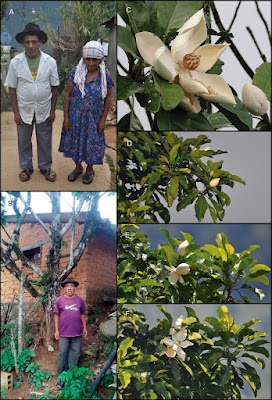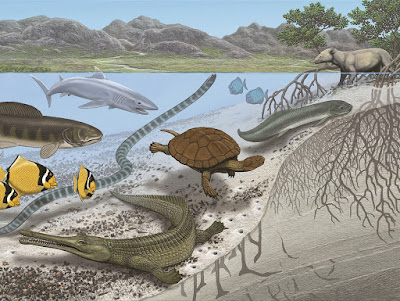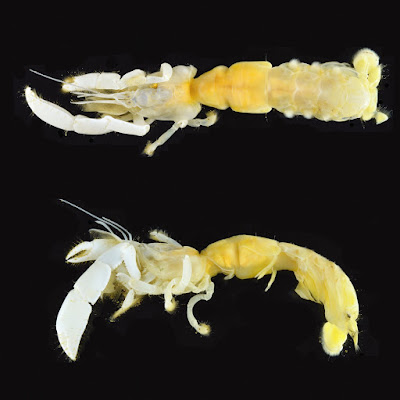[Most Recent Entries] [Calendar View]
Tuesday, July 9th, 2019
| Time | Event | ||||
| 2:06a | [Botany • 2019] Magnolia yajlachhi (subsect. Talauma, Magnoliaceae) • Flower of the Heart, A New Species of Ceremonial, Medicinal, Conservation and Nurse Tree Relevance in the Zapotec Culture, Sierra Norte de Oaxaca, Mexico
Abstract A new species of Magnolia from Sierra de Juárez, Oaxaca, Mexico, is described and illustrated. Magnolia yajlachhi belongs to sect. Talauma, subsect. Talauma, locally known as “yajlachhi” (flower of the heart, in Zapotec). It shares with M. lacandonica the subglobose mature fruit and the entirely white petals, but differs from the latter in having fewer carpels and stamens; more lateral leaf veins per side; and seeds orange vs. scarlet-red. It shares with M. zoquepopolucae the subglobose fruit but differs from the latter in having fewer carpels and stamens; petals entirely white vs. purplish in the upper portion (¾); more lateral leaf-veins per side; and seeds orange vs. scarlet-red. It shares with M. mexicana a similar number of carpels and stamens but it differs from the latter in having subglobose fruits to widely ovoid-depressed vs. widely ellipsoid; more leaf-veins per side; petals entirely white vs. adaxially purplish in the upper portion (¾); and seeds orange vs. scarlet-red. A key to Mexican species of sect. Talauma subsect. Talauma is provided. This species was assessed as Critically Endangered (CR). The species has a ceremonial and medicinal, conservation and nurse tree relevance in the Zapotecan culture. Keywords: Magnoliids, medicinal use, nurse tree, Sierra de Juárez, Talauma. Zapotec Magnolia yajlachhi A.Vázquez & Domínguez-Yescas, sp. nov. Type:— MEXICO. Oaxaca: Mpio. San Juan Juquila Vijanos, Lachi-Luguiaj or Llano de Piedra, rare in coffee plantations that used to be cloud forest habitat in secondary Liquidambar-Pinus forest, property of Procoro Pascual, ..., 1269 m, 2 Sep 2018 (fr.), Pascual Domínguez 1 (holotype: IBUG!; isotypes: CORU!, ENCB!, HUAP!, MEXU!, OAX!, SERO!, XAL!). Magnolia yajlachhi shares with M. lacandonica the mature subglobose fruit and entirely white petals, but differs from the latter in having carpels less numerous (36–41 vs. 61–80) and marked vs. inconspicuously marked; stamens less numerous (166–175 vs. 198–248), leaf-veins per side more numerous (13–14 vs. 10–11); and seeds orange vs. scarlet. Magnolia yajlachhi shares with M. zoquepopolucae the subglobose fruit but differs from the latter in having carpels less numerous (36–41 vs. 46–56); stamens less numerous (166–175 vs. 200), petals entirely white vs. purplish in the apical portion (¾); lateral leaf-veins per side more numerous (13–14 vs. 10–11); and seeds orange vs. scarlet. Magnolia yajlachhi shares with M. mexicana a similar number of carpels and stamens but it differs from the latter in having shorter petals (7.5–7.7 vs. 9.0–10.0 cm) and entirely white vs. adaxially purplish in the apical portion (¾); fruits smaller (5.4–10.0 vs. 10.0–15.0 cm) and widely ovoid-depressed to subglobose vs. widely ellipsoid; leaf-veins per side more numerous (13–14 vs. 10–12); and seeds orange vs. scarlet (Table 1, Fig. 8). Reyna Domínguez‐Yescas and José Antonio Vázquez‐García. 2019. Flower of the Heart, Magnolia yajlachhi (subsect. Talauma, Magnoliaceae), A New Species of Ceremonial, Medicinal, Conservation and Nurse Tree Relevance in the Zapotec Culture, Sierra Norte de Oaxaca, Mexico. Phytotaxa. 393(1).1; 21–34. DOI: 10.11646/phytotaxa.393.1.2 | ||||
| 3:04a | [Paleontology • 2019] Stratigraphy and Paleobiology of the Upper Cretaceous-Lower Paleogene Sediments from the Trans-Saharan Seaway in Mali
Abstract An epicontinental sea bisected West Africa periodically from the Late Cretaceous to the early Eocene, in dramatic contrast to the current Sahara Desert that dominates the same region today. Known as the Trans-Saharan Seaway, this warm and shallow ocean was a manifestation of globally elevated sea level associated with the rapid break-up of the supercontinent Gondwana in the late Mesozoic. Although it varied in size through time, the Trans-Saharan Seaway is estimated to have covered as much as 3000 km2 of the African continent and was approximately 50 m deep. The edges of the sea were defined in part by the high topography of the Precambrian cratons and mobile belts of West Africa. Over its approximately 50 million year episodic existence, through six major periods of transgression and regression, the Trans-Saharan Seaway left behind extensive nearshore marine sedimentary strata with abundant fossils. The waters that yielded these deposits supported and preserved the remains of numerous vertebrate, invertebrate, plant, and microbial species that are now extinct. These species document a regional picture of ancient tropical life that spanned two major Earth events: the Cretaceous-Paleogene (K-Pg) boundary and the Paleocene-Eocene Thermal Maximum (PETM). Whereas extensive epeiric seas flooded the interior portions of most continents during these intervals, the emerging multicontinental narrative has often overlooked the Trans-Saharan Seaway, in part because fundamental research, including the naming of geological formations and the primary description and analysis of fossil species, remained to be done. We provide such synthesis here based on two decades of fieldwork and analyses of sedimentary deposits in the Republic of Mali. Northern parts of the Republic of Mali today include some of the farthest inland reaches of the ancient sea. We bring together and expand on our prior geological and paleontological publications and provide new information on ancient sedimentary rocks and fossils that document paleoequatorial life of the past. Ours is the first formal description of and nomenclature for the Upper Cretaceous and Lower Paleogene geological formations of this region and we tie these names to regional correlations over multiple modern territorial boundaries. The ancient seaway left intriguing and previously unclassified phosphate deposits that, quite possibly, represent the most extensive vertebrate macrofossil bone beds known from anywhere on Earth. These bone beds, and the paper shales and carbonates associated with them, have preserved a diverse assemblage of fossils, including a variety of new species of invertebrates and vertebrates, rare mammals, and trace fossils. The shallow marine waters included a wide range of paleoenvironments from delta systems, to hypersaline embayments, protected lagoons, and carbonate shoals. Our overarching goal has been to collect vertebrate fossils tied to a K-Pg stratigraphic section in Africa. We provide such a section and, consistent with prior ideas, indicate that there is a gap in sedimentation in Malian rocks in the earliest Paleocene, an unconformity also proposed elsewhere in West Africa. Our phylogenetic analyses of several vertebrate clades across the K-Pg boundary have clarified clade-by-clade species-level survivorship and range extensions for multiple taxa. Few macrofossil species from the Trans-Saharan Seaway show conspicuous change at either the K-Pg boundary or the PETM based on current evidence, although results are very preliminary. Building on our earlier report of the first record of rock-boring bivalves from the Paleocene of West Africa, we further describe here a Cretaceous and Paleogene mollusk fauna dominated by taxa characteristic of the modern tropics. Among the newly discovered fossil osteichthyans, large body size characterizes both the pycnodonts and a new freshwater Eocene catfish species, one of the largest fossil catfishes found in Africa. Our new paleoecological and faunal reconstructions show an evergreen, broadleaf forest that included some of the oldest mangroves known. The ancient Malian ecosystem had numerous apex predators including Crocodyliformes, Serpentes, and Amiidae, some of which were among the largest species in their clades. The Trans-Saharan Seaway exhibited intermittent isolation from major seas. This environmental variable may have created aquatic centers of endemism, stimulating selection for gigantism as previously observed for species on terrestrial islands. Maureen A. O'Leary, Mamadou L. Bouaré, Kerin M. Claeson, Kelly Heilbronn, Robert V. Hill, Jacob A. McCartney, Jocelyn A. Sessa, Famory Sissoko, Leif Tapanila, Elisabeth Wheeler and Eric M. Roberts. 2019. Stratigraphy and Paleobiology of the Upper Cretaceous-Lower Paleogene Sediments from the Trans-Saharan Seaway in Mali. Bulletin of the American Museum of Natural History. 436; 1–177. digitallibrary.AMNH.org/handle/2246/6950 Large Sea Snakes, Giant Catfish Once Swam in the Sahara AMNH.org/explore/news-blogs/research-pos Ancient Saharan seaway shows how Earth's climate and creatures can undergo extreme change phys.org/news/2019-07-ancient-saharan-se | ||||
| 7:21a | [Crustacea • 2019] Laticallichirus gen. nov. • A New Genus for “Neocallichirus” grandis Karasawa & Goda, 1996, A Ghost Shrimp Species (Decapoda: Axiidea: Callianassidae) Heretofore Known Only by Fossil Materials
Abstract A new genus of the family Callianassidae, Laticallichirus, is established for “Neocallichirus” grandis Karasawa & Goda, 1996, a ghost shrimp species heretofore represented only by fossil materials from the middle to upper Pleistocene of Japan. The newly collected specimens came from two Japanese localities: Numazu, Shizuoka Prefecture (Suruga Bay) and Tosa, Kochi Prefecture (Tosa Bay), included within the known geographical range derived from fossil records. The species identification was based on the close agreement in the cheliped morphology and the known fossil distributions. The new genus is assigned to the subfamily Callichirinae Manning & Felder, 1991, and compared with seven genera, Balsscallichirus Sakai, 2011, Callichirus Stimpson, 1866, Callichiropsis Sakai, 2010, Grynaminna Poore, 2000, Michaelcallianassa Sakai, 2002, Lepidophthalmus Holmes, 1904 and Podocallichirus Sakai, 1999, all characterized by the antennular peduncle being longer and stouter than the antennal peduncle. The new genus is characteristic in combination of the following characters: rostrum spiniform; maxilliped 3 devoid of exopod; ischium-merus of maxilliped 3 broadly operculiform; maxilliped 3 ischium devoid of crista dentata; major cheliped devoid of meral hook or associated lobe-like structure; tergites of the pleomeres 3–5 without conspicuous ornamentation; male pleopod 2 biramous, its endopod devoid of appendices interna and masculina; uropodal endopod suboval in shape; telson distinctly wider than long, with shallowly concave posterior margin. The genetic analysis using the mitochondrial 16S rRNA places the new genus as sister to Callichirus Stimpson, 1866, although bootstrap support for major branches is generally low. The newly collected specimens were found in burrows in soft sediments of shallow subtidal zone being accessible at low tide. Keywords: Crustacea, Callichirinae, fossil, genetic analysis, Laticallichirus grandis, Pleistocene, 16S rRNA
Tomoyuki Komai, Hiroyuki Yokooka, Yumi Henmi and Gyo Itani. 2019. A New Genus for “Neocallichirus” grandis Karasawa & Goda, 1996, A Ghost Shrimp Species (Decapoda: Axiidea: Callianassidae) Heretofore Known Only by Fossil Materials. Zootaxa. 4604(3); 461–481. DOI: 10.11646/zootaxa.4604.3.4 | ||||
| 7:36a | [Botany • 2019] A Phylogenetic and Biogeographic Study of Rafflesia (Rafflesiaceae) in the Philippines: Limited Dispersal and High Island Endemism
Highlights • Philippine Rafflesia is monophyletic. • Rafflesia phylogeny displays strong biogeographic signal. • Borneo probably constitutes the ancestral range of Rafflesia. • Rafflesia lineages might be older and evolved more gradually than previously assumed. • Rafflesia possibly disperse poorly between islands. Abstract Rafflesia (Rafflesiaceae) is a small endo-holoparasitic Asian plant genus known for its exceptionally large flowers, rare species, and high island endemism. In this study, phylogenetic (parsimony and Bayesian inference) and biogeographic (BioGeoBEARS) analyses of DNA sequence data (atp6 and matR genes, and nad1 B-C intron from the mitochondrial genome, and the nuclear ribosomal internal transcribed spacer) were used to reconstruct the phylogenetic relationships among 12 of the 13 known Philippine Rafflesia species and to determine the timing and pathways of their diversification. The results of these analyses confirm those of previous Rafflesia studies (which were largely focused on non-Philippine species) in finding pronounced biogeographic patterns. They suggest that dispersal between islands has been relatively uncommon, and indicate that the high island endemism of Rafflesia is a result of poor inter-island dispersal abilities. The results further suggest that its ancestral range might have been in Borneo, and that its lineages and species evolved earlier and more gradually than previously assumed. Keywords: biogeography, dispersal, parasitic plants, divergence time, Malesia, parasitic plants Pieter B. Pelser, Daniel L. Nickrent, Benjamin W. van Ee and Julie F. Barcelona. 2019. A Phylogenetic and Biogeographic Study of Rafflesia (Rafflesiaceae) in the Philippines: Limited Dispersal and High Island Endemism. Molecular Phylogenetics and Evolution. In Press. DOI: 10.1016/j.ympev.2019.106555 |
| << Previous Day |
2019/07/09 [Calendar] |
Next Day >> |




















